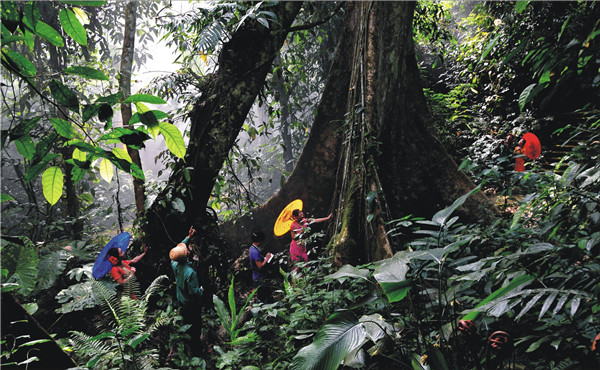Conservationist Stuart Pimm makes regular visits to China to study its diverse ecosystem, Chen Liang reports.

One of the endangered golden lion tamarins in tropical rainforest (Image by XTBG)
During his three-week stay in Xishuangbanna Tropical Botanical Garden in May, professor Stuart Pimm from Duke University went bird-watching with his colleague Clinton N. Jenkins and PhD student Li Binbin almost every morning.
The 65-year-old ecologist is the author of more than 270 scientific papers and four books, and has been ranked as one of the most highly cited environmental scientists for over a decade by the Institute of Scientific Information, which maintains citation databases covering thousands of academic journals. For him, birding has not been only a hobby since he was 12 years old, but also a window to “understand what’s happening in nature”.
Partly because of his hobby, he has been to China 10 times. The first time was to Taiwan 20 years ago. Fifteen years ago he came to the Chinese mainland, visiting Sichuan and Hainan provinces.
This is the fourth consecutive year he has visited the country, he said, because he “has a very kind interest in China’s biodiversity”, particularly China’s protected areas.
“China has set aside a lot of areas as nature reserves. They are very, very impressive and are beginning to attract a lot of tourists in China. I think increasingly people in the West are coming to China to see China’s biodiversity,” the British-born professor told China Daily at the botanical garden in Menglun township, Xishuangbanna, Yunnan province. “An interesting issue is how China manages its biodiversity.”
Through his visits to China and the Chinese students and professors who have visited his laboratory and worked with him, he said, he thinks that China is struggling with many issues of how to manage its protected areas.
“It’s clear that there is a lot of hunting, illegal killing of animals here (in Xishuangbanna),” he said. In the Wanglang National Nature Reserve in Sichuan, where his student Li Binbin is doing her research, he said that people graze horses within the reserve and have fragmented giant panda’s habitat.
“I see national park reserves worrying about their finances,” he said. “When you have beautiful facilities to let people stay, then you have places such as Jiuzhaigou — they have millions of visitors a year. I think they actually manage these visitors very well. Of course there are many management issues.”
For all of these issues, the ecologist said that he has the experience to find solutions. He worked and taught in Africa for nearly 20 years, concentrating on topics related to wildlife and ecosystem conservation.
His other research areas include the Everglades of Florida in the United States and tropical forests in South America, especially the Atlantic Forest of Brazil and the northern Andes, two of the world’s hotspots for threatened species. “I can be helpful and useful,” he said.
According to professor Corlett, director of botanical garden’s Center for Integrative Conservation, who invited Pimm for the field research, Pimm is a world leader in the study of present-day extinction and what can be done to prevent it. His research covers the reasons why species become extinct, how fast they do so, the global patterns of habitat loss and species extinction, and, importantly, the management consequences of this research. “I am looking for ways to prevent the extinction,” Pimm said.
One of the problems in Xishuangbanna is that “the forests here are in isolated patches”, he said. “If the forests are isolated, there won’t be a lot of species. We don’t have hornbills in the forests here. Probably we hunted them out. Also (it’s) because forests here are isolated from forests further away that do have hornbills.”
At the botanical garden, Pimm, Jenkins and Li worked on developing conservation priorities in Southeast Asia from “Sichuan to Singapore”, mainly by mapping the biodiversity of the whole region, based on species range maps for mammals, the amphibians and cone snails, and from the BirdLife International.
After completing the mapping, said Jenkins, who is vice-president of SavingSpecies, a conservation NGO that was founded in 2006 and has Pimm as its president, they can find key natural corridors to connect fragmented forests in the region. “We’re not doing this (mapping) just as an academic exercise. We’re doing it because we want to make a difference on the ground,” Pimm explained. “From strategic mapping to tactical mapping, that’s what we want to do.”
After identifying key wildlife corridors in the Atlantic Forest of Brazil, Pimm, Jenkins and their colleagues at SavingSpecies actually raised money to allow local NGOs to buy land for the corridors and reforest the land, beginning in 2007.
The work has resulted in increasing the estimated wild population of the golden lion tamarin, a highly endangered monkey, from the low hundreds a couple of decades ago to more than 3,000 today.
“Naturally, China needs developing, needs agriculture, needs rubber. But it is possible to design rubber plantations in a way that allows natural corridors between remaining patches of forests. We’re looking for opportunities to help reserve managers connect fragments,” Pimm said.
Although purchasing land for conservation is not a practical solution in China, the conservationist said, “Trying to establish connection between the remaining habitats is something very important and very practical. We can’t save everything, but we can have more wildlife if we connect what we can.”
So in his future work, he expects to give advice and make recommendations to the Chinese authorities on “where conservation priorities are” and “where other protected areas should be”. Also he wants to help, train and mentor this new generation of Chinese conservation biologists.
“You have incredible biodiversity in China, and the one thing I can do is to share some of my experiences with my Chinese students and see what happens,” he said.
Contact the writer at chenliang@chinadaily.com.cn
URL:http://www.pressreader.com/canada/china-daily-canada/20150703/281698318407568/TextView

